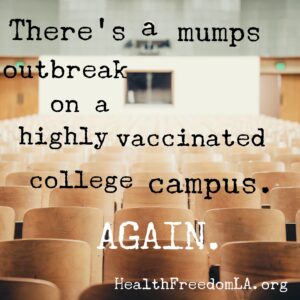
Mumps on a highly vaccinated Louisiana college campus?! You don’t say?!
That’s probably because any vaccine-acquired immunity will wane just in time to go to college.
But it’s not just college campuses. Fully vaccinated professional hockey teams and entire crews on board naval ships have been affected by the MMR’s inevitable shortcoming – waning immunity.
Even this fully vaccinated nurse and her fully vaccinated family were impacted by waning vaccine-acquired immunity:
Basically, people in any close-contact setting are at risk, vaccinated or not.
The vaccine in question? The MMR. The MMR is a trivalent vaccine that is supposed to protect you from measles, mumps, and rubella, with the first dose given around 12 months and the second dose around 4 years old.
So how does this happen? Why does this keep happening?
Let’s break it down:
- The vaccine is plagued by low efficacy and waning immunity, with as much as a 69% decline in antibodies during the first eight years after the second dose.(1,2,3,4)
- Fully vaccinated populations can spread and catch mumps.(5,6,7)
- Merck has been in federal court since 2010 on fraud charges in a whistleblower suit; their own virologists accused Merck of falsifying data and tainting samples.(8,9)
- The vaccine program has shifted the age of onset to an older population who is at a greater risk for serious complications while also leaving the most vulnerable (infants) at risk. This was foreseen back in 1955 before the mumps vaccine was even developed.(10,11,12)
Luckily, for the vast majority of people mumps is a mild illness that runs its course without any specific treatment. Mumps was such a mild, common illness with low rates of morbidity, mortality, and disability, that the need or value of a vaccine was even questioned.(12)
So don’t let the media scare you. College kids may need to take a break from making out, but last we checked that wasn’t an emergency. ?
References:
- “Increased reports of mumps in vaccinated populations prompted a review of the performance of mumps vaccines . . . There was evidence of waning immunity, which is a likely factor in mumps outbreaks, aggravated by possible antigenic differences between the vaccine strain and outbreak strains . . . Our findings indicate the need for more-effective mumps vaccines and/or for review of current vaccination policies to prevent future outbreaks.”
Mumps Outbreaks in Vaccinated Populations: Are Available Mumps Vaccines Effective Enough to Prevent Outbreaks?
academic.oup.com/cid/article/47/11/1458/282575 - “Immunity against mumps virus appears insufficient in a fraction of college-aged people who were vaccinated in childhood, research indicates. The findings highlight the need to better understand the immune response to mumps and mumps vaccines.”
Mumps study shows immunity gaps among vaccinated people
sciencedaily.com/releases/2019/09/190902181607.htm - “During 2010-2015, multiple mumps outbreaks among highly vaccinated populations in close-contact settings occurred. Most cases occurred among vaccinated young adults, suggesting that waning immunity played a role.”
Characteristics of Large Mumps Outbreaks in the United States, July 2010-December 2015
ncbi.nlm.nih.gov/pubmed/30204850 - “During the first 8 years after the second dose (1987–1995), the decline in levels of antibodies against all 3 viruses was significant (P<.001); the decline was 50%, 69%, and 58% for measles, mumps, and rubella, respectively. From then on, the antibody decline was substantially smaller but still significant: 23% for measles, from 957 to 729 mIU/mL (P<.001); 22% for mumps, from 1:767 to 1:597 (P<.001); and 21% for rubella, from 28 to 22 IU/mL (P<.05).”
Persistence of Measles, Mumps, and Rubella Antibodies in an MMR-Vaccinated Cohort: A 20-Year Follow-up
academic.oup.com/jid/article/197/7/950/798890 - “A US Navy warship deployed to the Persian Gulf has been stuck at sea for months due to a viral outbreak of what’s likely the mumps, and servicemembers are continuing to fall ill, raising the total number of affected personnel to 27 . . . mumps [is] one of a number of illnesses that all US military personnel are vaccinated against . . . Unfortunately, the mumps portion of the measles, mumps, and rubella (MMR) vaccine is the least effective of the three components, providing 88% effectiveness after completion of the two dose series.”
The Navy’s fighting to get a rare viral mumps outbreak under control after it stranded a US warship at sea, March 2019
businessinsider.com/uss-fort-mchenry-sailors-are-still-falling-ill-in-viral-mumps-outbreak-2019-3?fbclid=IwAR0mDeKh5mvZV7W-AEj8Z-yq_76r_oKVRqrYZEthUucitEkjfSp7ZoJBMjU?utm_source=copy-link&utm_medium=referral&utm_content=topbar - “The health department said all but one of the 26 people with mumps had been fully vaccinated.”
More than 2 dozen mumps cases seen at University of Arkansas, December 6, 2019
apnews.com/4f45cf311abb16d3c9f0b012090e534b - “Public health officials are investigating an outbreak of six mumps cases . . . The outbreak is among a group of residents and health care personnel . . . all six of the adult patients had been vaccinated against the disease. She said the mumps vaccine is about 88 percent effective and immunity can wane.”
Mumps Outbreak In Denver Investigated
denver.cbslocal.com/2016/02/24/mumps-outbreak-in-denver-county-investigated/ - “Specifically, the suit claims Merck manipulated the results of clinical trials beginning in the late 1990s so as to be able to report that the combined mumps vaccine . . . is 95 percent effective, in an effort to maintain its exclusive license to manufacture it.”
Merck Whistleblower Suit A Boon to Vaccine Foes Even As It Stresses Importance of Vaccines
forbes.com/sites/gerganakoleva/2012/06/27/merck-whistleblower-suit-a-boon-to-anti-vaccination-advocates-though-it-stresses-importance-of-vaccines/#49ff53f69678 - “Merck has known for a decade that its mumps vaccine is ‘far less effective’ than it tells the government, and it falsified test results and sold millions of doses of ‘questionable efficacy,’ flooding and monopolizing the market . . . Starting in the late 1990s, Merck set out on its sham testing program with the objective of ‘report[ing] efficacy of 95 percent or higher regardless of the vaccine’s true efficacy.’ . . . Merck did not test the vaccine’s ability to protect children against a “wild-type” mumps virus, which is ‘the type of real-life virus against which vaccines are generally tested,’ the complaint states. Instead, Chatom says, Merck tested children’s blood using its own attenuated strain of the virus. ‘This was the same mumps strain with which the children were vaccinated,’ the complaint states . . . The end result of this deviation … was that Merck’s test overstated the vaccine’s effectiveness,’ Chatom claims. Merck also added animal antibodies to blood samples to achieve more favorable test results, though it knew that the human immune system would never produce such antibodies, and that the antibodies created a laboratory testing scenario that ‘did not in any way correspond to, correlate with, or represent real life … virus neutralization in vaccinated people,’ . . . ‘But no amount of extra time or dosages will be enough to eliminate the disease when the vaccine does not work as represented in the labeling,” the complaint states.”
Class Says Merck Lied About Mumps Vaccine
courthousenews.com/Class-Says-Merck-Lied-About-Mumps-Vaccine/ - “During the prevaccine era, nearly everyone in the United States experienced mumps, and 90% of cases occurred among children aged <15 years . . . Of the 219 cases reported in Iowa, the median patient age was 21 years (range: 3-85 years), with 48% of patients aged 17-25 years; 30% were known to be college students . . . the United Kingdom (UK) experienced a recent mumps epidemic that peaked during 2005 with approximately 56,000 cases and a high attack rate among young adults.”
Mumps Epidemic – Iowa, 2006, Morbidity and Mortality Weekly Report by the Centers for Disease Control and Prevention
cdc.gov/mmwr/preview/mmwrhtml/mm55d330a1.htm?fbclid=IwAR3r2ou9IYlVVZeGQz-sosSwo_HPqgKUUPhk61tedtz078SL6T5g_zW9QHo - “Since 1998, however, several mumps outbreaks have occurred in adolescents and young adults; these culminated in a national epidemic, mainly affecting university students, in 2004 and 2005 . . . Declining protection over time, and possible antigenic differences between the vaccine and outbreak strains, have been suggested as contributory factors (7,16,17). In the absence of natural boosting, therefore, future mumps epidemics may be unavoidable in vaccinated populations living in crowded, semiclosed settings such as colleges . . . Because mumps is more severe in adults, increasing numbers of mumps cases in young adults in the postvaccine era could be expected to lead to a high rate of complications . . . The mumps outbreak in England and Wales led to a clear increase in hospitalizations caused by mumps complications, which mirrored the outbreak curve . . . The estimated complication rates were lower in younger persons . . . As reports of mumps outbreaks in highly immunized populations of older teenagers and young adults continue to occur, the long-term effects of mumps complications may be substantial.”
Mumps Complications and Effects of Mumps Vaccination, England and Wales, 2002–2006
ncbi.nlm.nih.gov/pmc/articles/PMC3377415/ - “If it can be assumed that the eventual control of chickenpox and mumps will depend on the development of an effective vaccine . . . the author . . . questions whether these two diseases are of sufficient gravity in terms of morbidity, mortality, or disability to justify universal and probably repeated vaccinations. Unless lifelong immunity is conferred by the primary vaccination, which seems unlikely, should the attack merely be postponed to older ages when economic loss and risk of complications are greater? Reporting of Notifiable Diseases
jstor.org/stable/41980697?seq=1#metadata_info_tab_contents

